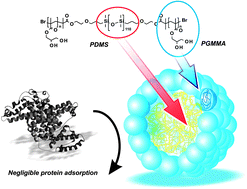The present study focuses on the synthesis of amphiphilic block copolymers containing poly(glycerol monomethacrylate) (PGMMA), showing the advantages of a protection/deprotection strategy based on silyl groups. PGMMA blocks were synthesized via ATRP started by a double functional poly(dimethyl siloxane) (PDMS) macroinitiator of molecular weight ≈7000 g mol−1. The resulting triblock copolymers were characterized by low polydispersity (generally ≤1.1) and their aggregation concentration in water was essentially dominated by the PDMS block length (critical aggregation concentration substantially invariant for GMMA degree of polymerization ≥30). For GMMA blocks with DP > 50, the self-assembly in water produced 35–50 nm spherical micelles, while shorter hydrophilic chains produced larger aggregates apparently displaying worm-like morphologies. Block copolymers with long GMMA chains (DP ≈ 200) produced particularly stable micellar aggregates, which were then selected for a preliminary assessment of the possibility of adsorption of plasma proteins (albumin and fibrinogen); using diffusion NMR as an analytical technique, no significant adsorption was recorded both on micelles and on soluble PGMMA employed as a control, indicating the possibility of a “stealth” behaviour.

